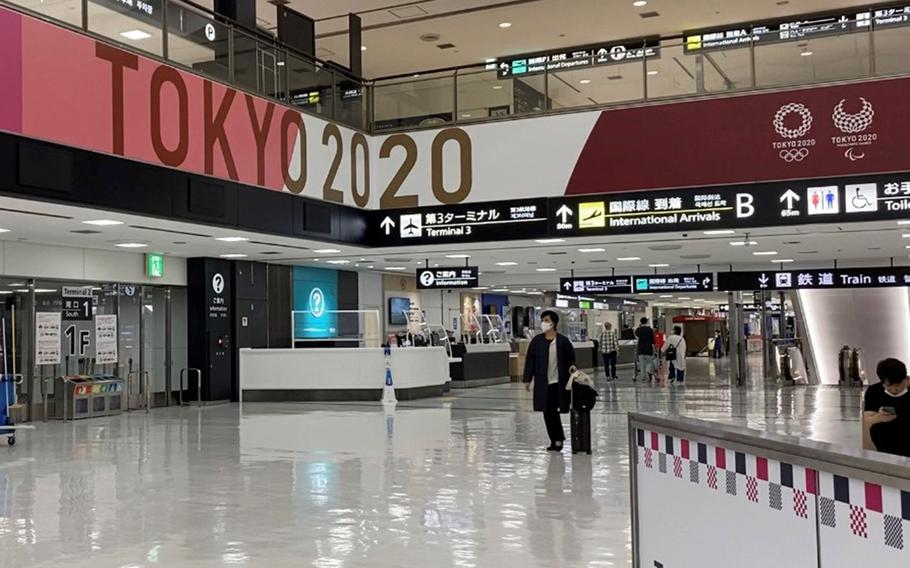
Narita International Airport outside Tokyo was mostly devoid of travelers on Saturday, May 22, 2021. ()
TOKYO — A warning for Americans to avoid travel to Japan due to its latest coronavirus surge will not affect U.S. athletes’ participation in the Tokyo Olympics, the chief cabinet secretary said Tuesday.
Katsumobu Kato told reporters in the capital that raising the risk level for U.S. travelers does not preclude their coming to Japan for the games starting July 23.
The U.S. State Department and Centers for Disease Control and Prevention on Monday recommended avoiding all travel to Japan, and placed it in their highest risk categories, level four.
“Because of the current situation in Japan even fully vaccinated travelers may be at risk for getting and spreading COVID-19 variants and should avoid all travel to Japan,” according to the CDC. “If you must travel to Japan, get fully vaccinated before travel.”
Japan itself limits entry to only a few categories of foreign travelers, including U.S. citizens covered by the status of forces agreement, but tourists are generally denied visas.
The United States Olympic and Paralympic Committee anticipates American athletes will compete safely at the Tokyo Games, according to The Associated Press on Tuesday.
“We feel confident that the current mitigation practices in place for athletes and staff by both the USOPC and Tokyo Organizing Committee, coupled with the testing before travel, on arrival in Japan, and during Games time, will allow for safe participation of Team USA athletes this summer,” the committee said Monday in a statement cited by the AP.
Kato said Japan earlier advised its citizens to avoid travel to the United States. Japan also requires arriving travelers to show a negative COVID-19 test result, stay off public transportation and quarantine upon arrival in an approved location.
“I understand that the United States has not taken measures to limit Japanese travelers from entering and that there are no specific talks about taking measures to do so,” Kato said. “Japan and the United States have been communicating closely and we will continue to take appropriate measures such as gathering information.”
The U.S. military in Japan reported 10 new cases as of 6 p.m. Tuesday, three at Yokota Air Base in western Tokyo, one at Sasebo Naval Base on the southern island of Kyushu, three at Kadena Air Base and three at Marine Corps bases on Okinawa.
Camps Hansen and Foster and Marine Corps Air Station Futenma each reported one new case of COVID-19, according to a Facebook post Tuesday by Marine Corps Installations Pacific.
At Yokota, three people tested positive between Saturday and Tuesday, according to a base Facebook post Tuesday. Two were already quarantined as new arrivals to Japan and the third was identified by public health authorities.
At Sasebo, a person with symptoms of COVID-19 symptoms tested positive Monday, according to a base Facebook post Tuesday.
Kadena said two people contracted COVID-19 after contact with previously infected individuals and a third fell ill with COVID-19 symptoms, according to a base Facebook post late Monday.
Ten of Japan’s prefectures, including its two largest cities, are in a public health emergency as a fourth coronavirus wave maintains its grip on those parts of the country. The fourth wave rivals the number of COVID-19 cases produced in the third and most damaging wave over the winter months. Some prefectures saw their worst phase of the pandemic in May.
Okinawa, the southernmost prefecture, reported its highest one-day tally of new cases on Tuesday, 256, which exceeded the previous one-day high, 231, on Saturday, according to public broadcaster NHK and prefectural data online.
The prefecture is in a public health emergency until June 20 and has asked U.S. commands there to abide by emergency measures by refraining from nonessential trips past 8 p.m., large gatherings and dining at restaurants that do not abide by emergency measures.
In Osaka, the nation’s second-largest metro area, the catastrophic spring surge is waning. Osaka prefecture, which this month saw thousands of new patients, on Monday reported 216 new coronavirus patients, less than half the 501 it reported Thursday, according to prefectural data online.
Still, the hospital beds available for the most severely ill patients are better than 80% full and more than 2,160 people have died in Osaka.
Tokyo on Monday reported another 542 people had contracted the virus, according to NHK. The number of new patients in the capital has declined from the same day the previous week for 12 days in a row, according to the broadcaster and city data.
ditzler.joseph@stripes.com Twitter: @JosephDitzler
kusumoto.hana@stripes.com Twitter: @HanaKusumoto